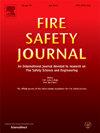高、高强度钢热浸镀锌组合梁在标准耐火试验中的性能
IF 3.4
3区 工程技术
Q2 ENGINEERING, CIVIL
引用次数: 0
摘要
与非镀锌钢相比,热浸镀锌钢板的发射率较低,特别是在温度低于500°C时,暴露在火中加热较慢,因此在没有额外被动防火保护的情况下,紧凑截面的耐火等级达到R30。使用镀锌高强度钢和更高强度钢,可以在复合梁中更有效、更经济地实现R30耐火。本文通过实验和数值分析对这些观点进行了研究。为评价热浸镀锌复合梁在热载荷和机械载荷下的性能,提出了大型标准耐火试验。测试包括各种梁的几何形状和深度,使用钢牌号S460M和S690QL。单对称梁的设计减少了顶部法兰厚度,底部法兰紧凑,以优化整体深度,改善火灾测试时的热响应。对S460M和S690QL钢的温度相关材料性能进行了表征,包括对两种钢进行稳态和瞬态拉伸试验,并将结果与DIN EN 1993-1-2中给出的结果进行了比较。在大型耐火试验中,采用不同连接方式的热浸镀锌二次梁连接在梁的中间,以研究不同连接方式所经历的温度。收集的测试数据用于验证和验证这种复合梁在暴露于标准火灾时的有限元模型,以及进一步的参数研究,检查复合梁的横截面几何形状、剪切连接程度和梁的总长度等元素。这些研究的结果有助于确定在标准火灾情况下热浸镀锌复合梁的螺柱剪切连接的最小要求程度。本文章由计算机程序翻译,如有差异,请以英文原文为准。

The performance of hot-dip galvanized composite beams made of high and higher strength steel in standard fire resistance tests
The lower emissivity of hot-dip galvanized steel sections as compared with non-galvanized steel, particularly at temperatures below 500 °C, results in slower heating when exposed to fire, thus enabling fire resistance ratings of R30 for compact cross-sections without additional passive fire protection. Using galvanized high and higher-strength steels allows R30 fire resistance to be achieved in composite beams more efficiently and cost-effectively. These ideas are investigated experimentally and via numerical analyses in this paper.
Large-scale standard fire resistance tests are presented to evaluate the performance of hot-dip galvanized composite beams under thermal and mechanical loads. The tests include a variety of beam geometries and depths, using steel grades S460M and S690QL. Single-symmetrical beams were designed with a reduced top flange thicknesses and compact bottom flanges to optimize overall depth and improve thermal response during fire testing. The temperature-dependent material properties of the S460M and S690QL steels is characterised, including steady state and transient tensile tests on both steels, and the results are compared with those given in DIN EN 1993-1-2. Hot-dip galvanized secondary beams with different connection types were connected in the middle of the beams during the large scale fire resistance tests so as to investigate temperatures experienced by differing connection details. The collected test data are used to validate and verify finite element models for such composite beams when exposed to standard fire exposures, alongside further parametric studies examining elements such as cross sectional geometry of the composite beam, the degree of shear connection, and the overall length of the beams. The outcomes of these studies contribute to the determination of the minimum required degree of stud shear connection for hot-dip galvanized composite beams in standard fire scenarios.
求助全文
通过发布文献求助,成功后即可免费获取论文全文。
去求助
来源期刊

Fire Safety Journal
工程技术-材料科学:综合
CiteScore
5.70
自引率
9.70%
发文量
153
审稿时长
60 days
期刊介绍:
Fire Safety Journal is the leading publication dealing with all aspects of fire safety engineering. Its scope is purposefully wide, as it is deemed important to encourage papers from all sources within this multidisciplinary subject, thus providing a forum for its further development as a distinct engineering discipline. This is an essential step towards gaining a status equal to that enjoyed by the other engineering disciplines.
 求助内容:
求助内容: 应助结果提醒方式:
应助结果提醒方式:


